Analyzing the Impacts of Business Complexity on Global Management
VerifiedAdded on 2023/06/06
|18
|4254
|207
Report
AI Summary
This research report explores the impacts of business complexity on global management, addressing the challenges and potential benefits for organizations operating internationally. It investigates the correlation between organizational performance and complex business environments, examining how stakeholders, organizational structure, and information systems influence complexity. The report reviews literature defining business complexity and its various forms, such as imposed complexity, industry complexity, and variety complexity. It further discusses mitigation strategies for management challenges associated with complexity, including the need for understanding market trends and aligning organizational design with objectives. The research uses a mixed-methods approach, analyzing data from reputable corporate firms to provide insights and recommendations for managers navigating the complexities of the global business landscape. Desklib provides access to this and similar assignments to aid students in their studies.
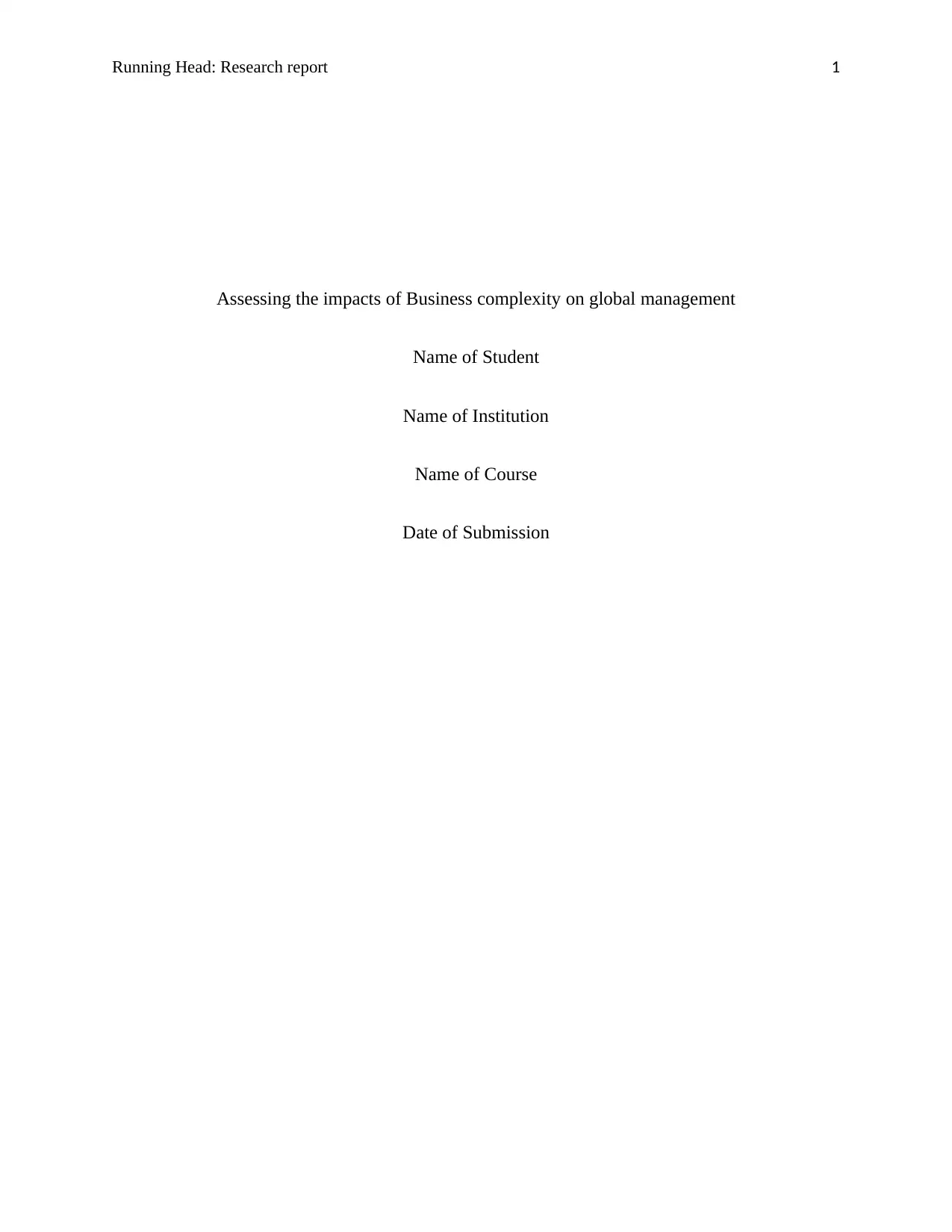
Running Head: Research report 1
Assessing the impacts of Business complexity on global management
Name of Student
Name of Institution
Name of Course
Date of Submission
Assessing the impacts of Business complexity on global management
Name of Student
Name of Institution
Name of Course
Date of Submission
Paraphrase This Document
Need a fresh take? Get an instant paraphrase of this document with our AI Paraphraser
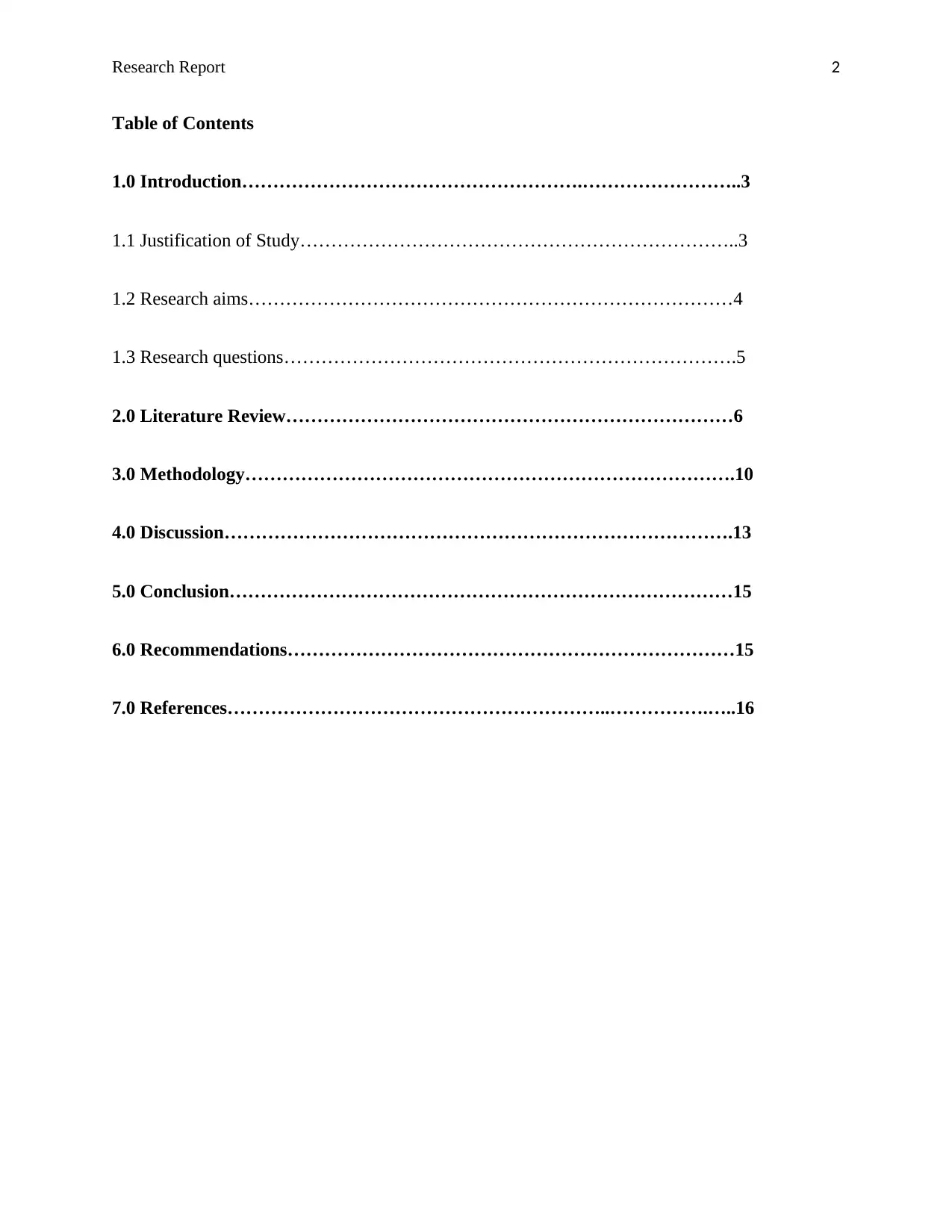
Research Report 2
Table of Contents
1.0 Introduction……………………………………………….……………………..3
1.1 Justification of Study……………………………………………………………..3
1.2 Research aims……………………………………………………………………4
1.3 Research questions……………………………………………………………….5
2.0 Literature Review………………………………………………………………6
3.0 Methodology…………………………………………………………………….10
4.0 Discussion……………………………………………………………………….13
5.0 Conclusion………………………………………………………………………15
6.0 Recommendations………………………………………………………………15
7.0 References……………………………………………………..…………….…..16
Table of Contents
1.0 Introduction……………………………………………….……………………..3
1.1 Justification of Study……………………………………………………………..3
1.2 Research aims……………………………………………………………………4
1.3 Research questions……………………………………………………………….5
2.0 Literature Review………………………………………………………………6
3.0 Methodology…………………………………………………………………….10
4.0 Discussion……………………………………………………………………….13
5.0 Conclusion………………………………………………………………………15
6.0 Recommendations………………………………………………………………15
7.0 References……………………………………………………..…………….…..16
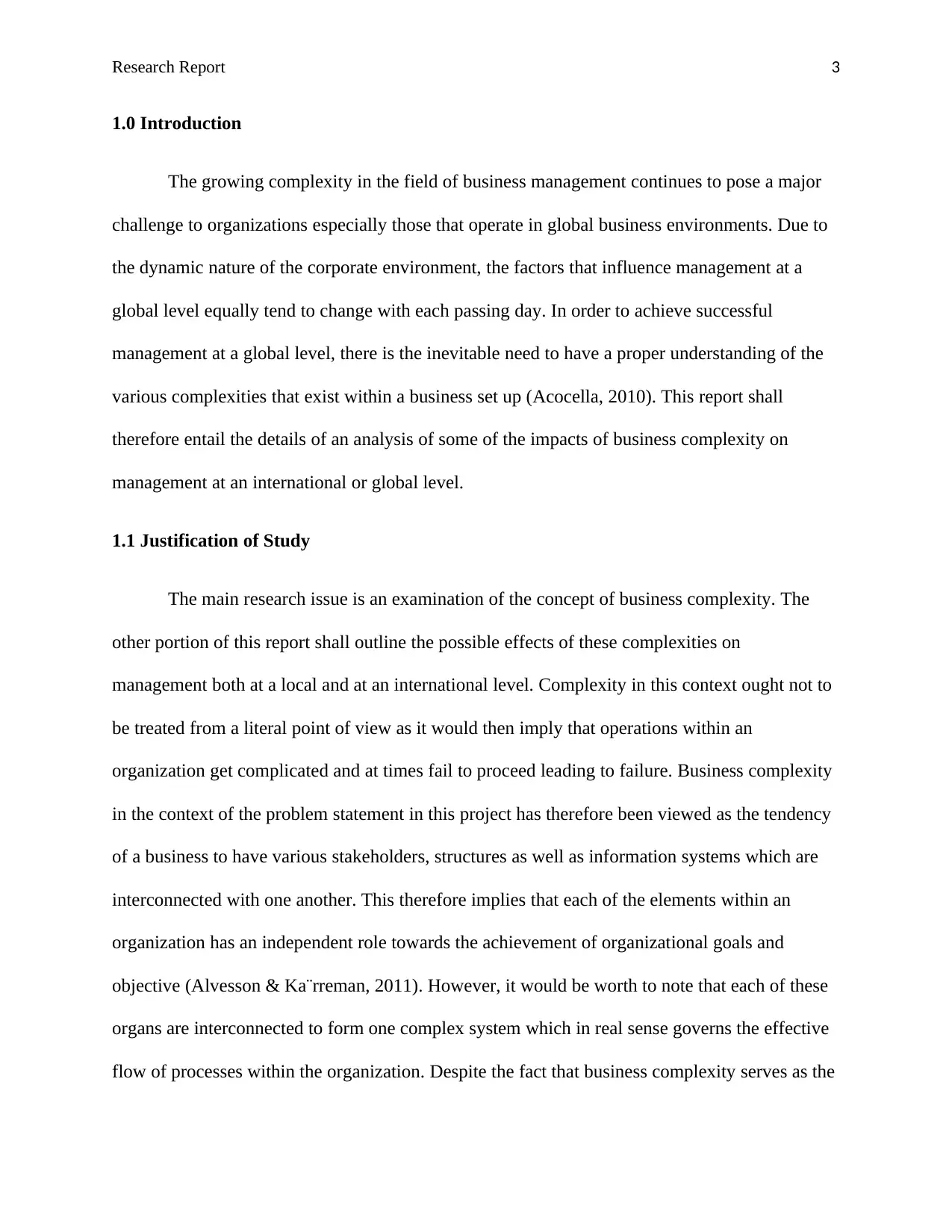
Research Report 3
1.0 Introduction
The growing complexity in the field of business management continues to pose a major
challenge to organizations especially those that operate in global business environments. Due to
the dynamic nature of the corporate environment, the factors that influence management at a
global level equally tend to change with each passing day. In order to achieve successful
management at a global level, there is the inevitable need to have a proper understanding of the
various complexities that exist within a business set up (Acocella, 2010). This report shall
therefore entail the details of an analysis of some of the impacts of business complexity on
management at an international or global level.
1.1 Justification of Study
The main research issue is an examination of the concept of business complexity. The
other portion of this report shall outline the possible effects of these complexities on
management both at a local and at an international level. Complexity in this context ought not to
be treated from a literal point of view as it would then imply that operations within an
organization get complicated and at times fail to proceed leading to failure. Business complexity
in the context of the problem statement in this project has therefore been viewed as the tendency
of a business to have various stakeholders, structures as well as information systems which are
interconnected with one another. This therefore implies that each of the elements within an
organization has an independent role towards the achievement of organizational goals and
objective (Alvesson & Ka¨rreman, 2011). However, it would be worth to note that each of these
organs are interconnected to form one complex system which in real sense governs the effective
flow of processes within the organization. Despite the fact that business complexity serves as the
1.0 Introduction
The growing complexity in the field of business management continues to pose a major
challenge to organizations especially those that operate in global business environments. Due to
the dynamic nature of the corporate environment, the factors that influence management at a
global level equally tend to change with each passing day. In order to achieve successful
management at a global level, there is the inevitable need to have a proper understanding of the
various complexities that exist within a business set up (Acocella, 2010). This report shall
therefore entail the details of an analysis of some of the impacts of business complexity on
management at an international or global level.
1.1 Justification of Study
The main research issue is an examination of the concept of business complexity. The
other portion of this report shall outline the possible effects of these complexities on
management both at a local and at an international level. Complexity in this context ought not to
be treated from a literal point of view as it would then imply that operations within an
organization get complicated and at times fail to proceed leading to failure. Business complexity
in the context of the problem statement in this project has therefore been viewed as the tendency
of a business to have various stakeholders, structures as well as information systems which are
interconnected with one another. This therefore implies that each of the elements within an
organization has an independent role towards the achievement of organizational goals and
objective (Alvesson & Ka¨rreman, 2011). However, it would be worth to note that each of these
organs are interconnected to form one complex system which in real sense governs the effective
flow of processes within the organization. Despite the fact that business complexity serves as the
⊘ This is a preview!⊘
Do you want full access?
Subscribe today to unlock all pages.

Trusted by 1+ million students worldwide
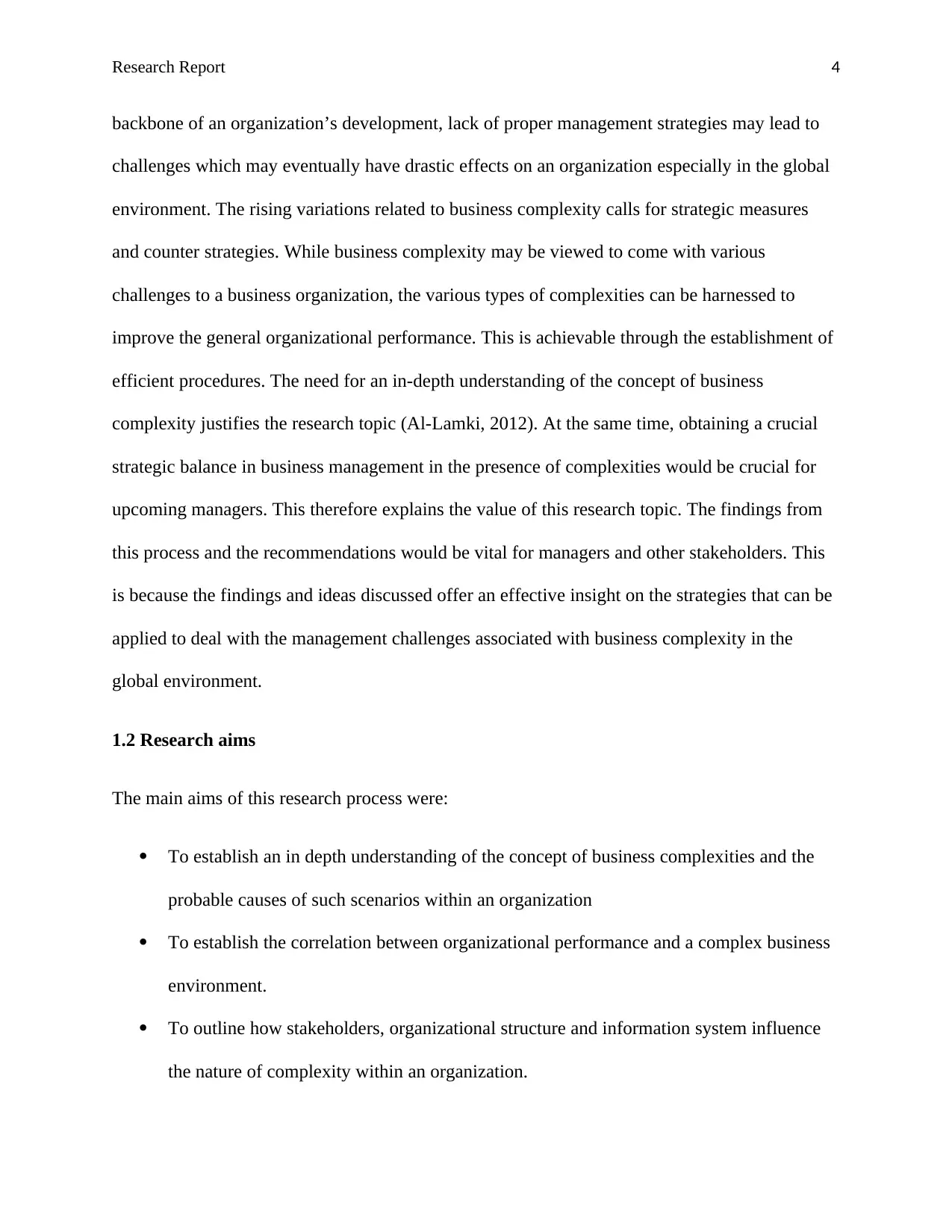
Research Report 4
backbone of an organization’s development, lack of proper management strategies may lead to
challenges which may eventually have drastic effects on an organization especially in the global
environment. The rising variations related to business complexity calls for strategic measures
and counter strategies. While business complexity may be viewed to come with various
challenges to a business organization, the various types of complexities can be harnessed to
improve the general organizational performance. This is achievable through the establishment of
efficient procedures. The need for an in-depth understanding of the concept of business
complexity justifies the research topic (Al-Lamki, 2012). At the same time, obtaining a crucial
strategic balance in business management in the presence of complexities would be crucial for
upcoming managers. This therefore explains the value of this research topic. The findings from
this process and the recommendations would be vital for managers and other stakeholders. This
is because the findings and ideas discussed offer an effective insight on the strategies that can be
applied to deal with the management challenges associated with business complexity in the
global environment.
1.2 Research aims
The main aims of this research process were:
To establish an in depth understanding of the concept of business complexities and the
probable causes of such scenarios within an organization
To establish the correlation between organizational performance and a complex business
environment.
To outline how stakeholders, organizational structure and information system influence
the nature of complexity within an organization.
backbone of an organization’s development, lack of proper management strategies may lead to
challenges which may eventually have drastic effects on an organization especially in the global
environment. The rising variations related to business complexity calls for strategic measures
and counter strategies. While business complexity may be viewed to come with various
challenges to a business organization, the various types of complexities can be harnessed to
improve the general organizational performance. This is achievable through the establishment of
efficient procedures. The need for an in-depth understanding of the concept of business
complexity justifies the research topic (Al-Lamki, 2012). At the same time, obtaining a crucial
strategic balance in business management in the presence of complexities would be crucial for
upcoming managers. This therefore explains the value of this research topic. The findings from
this process and the recommendations would be vital for managers and other stakeholders. This
is because the findings and ideas discussed offer an effective insight on the strategies that can be
applied to deal with the management challenges associated with business complexity in the
global environment.
1.2 Research aims
The main aims of this research process were:
To establish an in depth understanding of the concept of business complexities and the
probable causes of such scenarios within an organization
To establish the correlation between organizational performance and a complex business
environment.
To outline how stakeholders, organizational structure and information system influence
the nature of complexity within an organization.
Paraphrase This Document
Need a fresh take? Get an instant paraphrase of this document with our AI Paraphraser
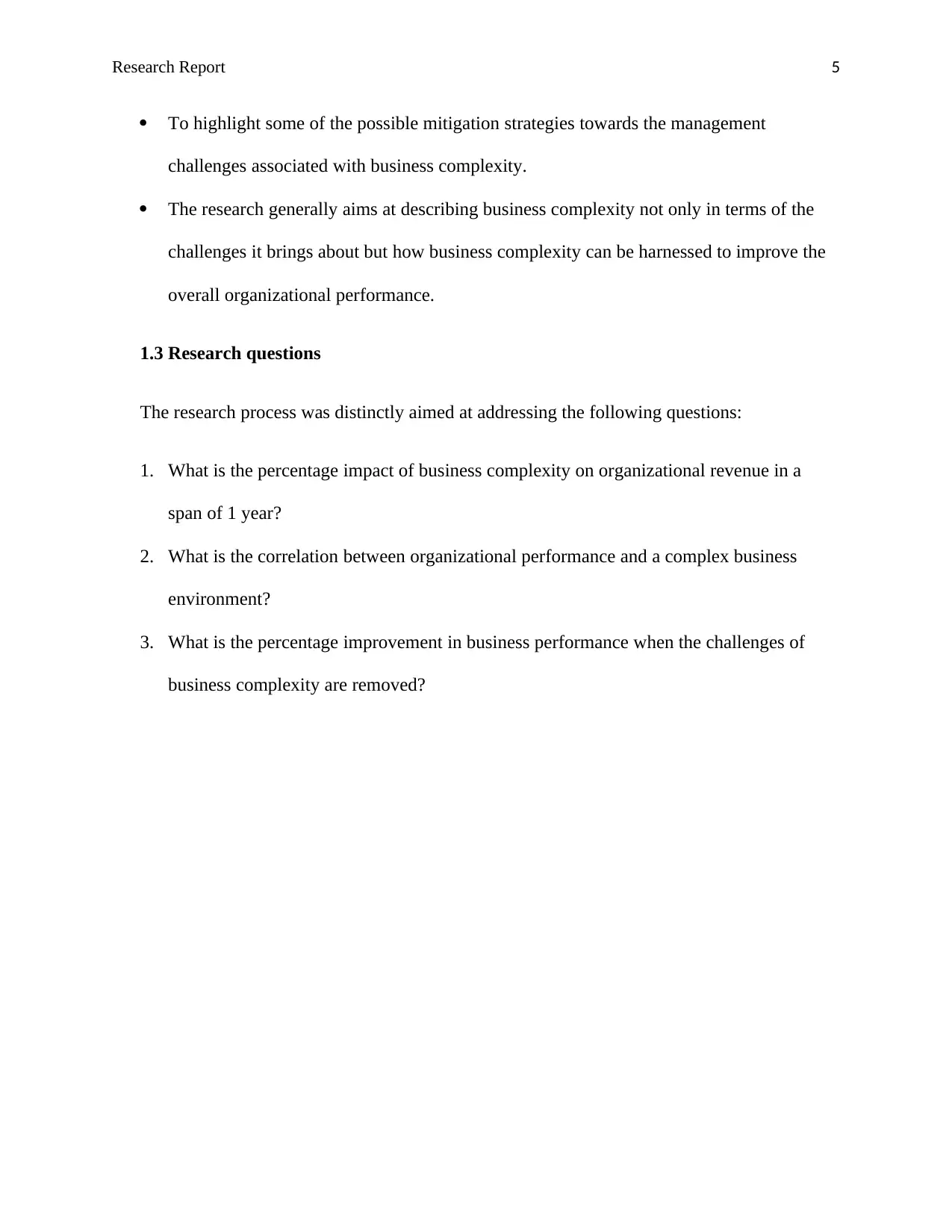
Research Report 5
To highlight some of the possible mitigation strategies towards the management
challenges associated with business complexity.
The research generally aims at describing business complexity not only in terms of the
challenges it brings about but how business complexity can be harnessed to improve the
overall organizational performance.
1.3 Research questions
The research process was distinctly aimed at addressing the following questions:
1. What is the percentage impact of business complexity on organizational revenue in a
span of 1 year?
2. What is the correlation between organizational performance and a complex business
environment?
3. What is the percentage improvement in business performance when the challenges of
business complexity are removed?
To highlight some of the possible mitigation strategies towards the management
challenges associated with business complexity.
The research generally aims at describing business complexity not only in terms of the
challenges it brings about but how business complexity can be harnessed to improve the
overall organizational performance.
1.3 Research questions
The research process was distinctly aimed at addressing the following questions:
1. What is the percentage impact of business complexity on organizational revenue in a
span of 1 year?
2. What is the correlation between organizational performance and a complex business
environment?
3. What is the percentage improvement in business performance when the challenges of
business complexity are removed?
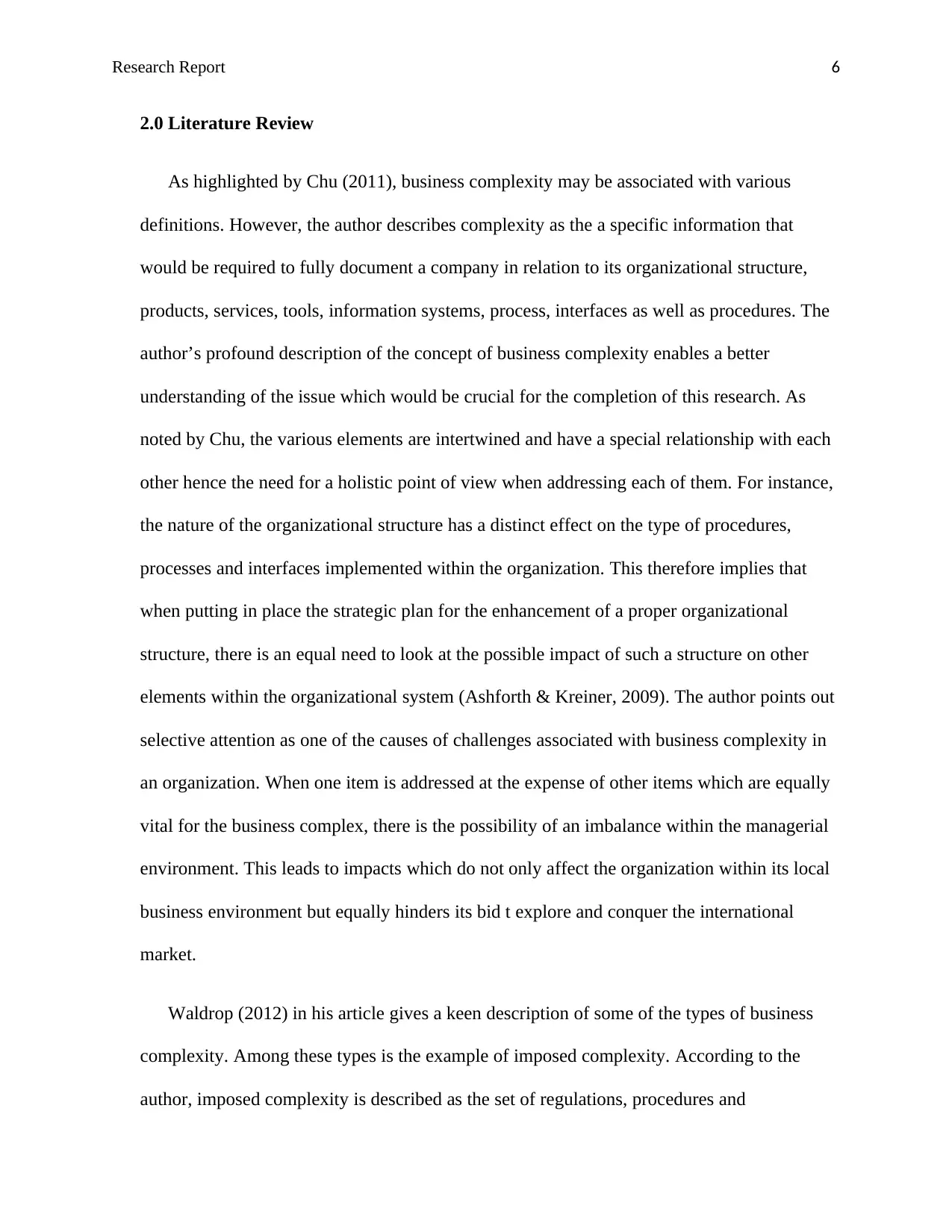
Research Report 6
2.0 Literature Review
As highlighted by Chu (2011), business complexity may be associated with various
definitions. However, the author describes complexity as the a specific information that
would be required to fully document a company in relation to its organizational structure,
products, services, tools, information systems, process, interfaces as well as procedures. The
author’s profound description of the concept of business complexity enables a better
understanding of the issue which would be crucial for the completion of this research. As
noted by Chu, the various elements are intertwined and have a special relationship with each
other hence the need for a holistic point of view when addressing each of them. For instance,
the nature of the organizational structure has a distinct effect on the type of procedures,
processes and interfaces implemented within the organization. This therefore implies that
when putting in place the strategic plan for the enhancement of a proper organizational
structure, there is an equal need to look at the possible impact of such a structure on other
elements within the organizational system (Ashforth & Kreiner, 2009). The author points out
selective attention as one of the causes of challenges associated with business complexity in
an organization. When one item is addressed at the expense of other items which are equally
vital for the business complex, there is the possibility of an imbalance within the managerial
environment. This leads to impacts which do not only affect the organization within its local
business environment but equally hinders its bid t explore and conquer the international
market.
Waldrop (2012) in his article gives a keen description of some of the types of business
complexity. Among these types is the example of imposed complexity. According to the
author, imposed complexity is described as the set of regulations, procedures and
2.0 Literature Review
As highlighted by Chu (2011), business complexity may be associated with various
definitions. However, the author describes complexity as the a specific information that
would be required to fully document a company in relation to its organizational structure,
products, services, tools, information systems, process, interfaces as well as procedures. The
author’s profound description of the concept of business complexity enables a better
understanding of the issue which would be crucial for the completion of this research. As
noted by Chu, the various elements are intertwined and have a special relationship with each
other hence the need for a holistic point of view when addressing each of them. For instance,
the nature of the organizational structure has a distinct effect on the type of procedures,
processes and interfaces implemented within the organization. This therefore implies that
when putting in place the strategic plan for the enhancement of a proper organizational
structure, there is an equal need to look at the possible impact of such a structure on other
elements within the organizational system (Ashforth & Kreiner, 2009). The author points out
selective attention as one of the causes of challenges associated with business complexity in
an organization. When one item is addressed at the expense of other items which are equally
vital for the business complex, there is the possibility of an imbalance within the managerial
environment. This leads to impacts which do not only affect the organization within its local
business environment but equally hinders its bid t explore and conquer the international
market.
Waldrop (2012) in his article gives a keen description of some of the types of business
complexity. Among these types is the example of imposed complexity. According to the
author, imposed complexity is described as the set of regulations, procedures and
⊘ This is a preview!⊘
Do you want full access?
Subscribe today to unlock all pages.

Trusted by 1+ million students worldwide
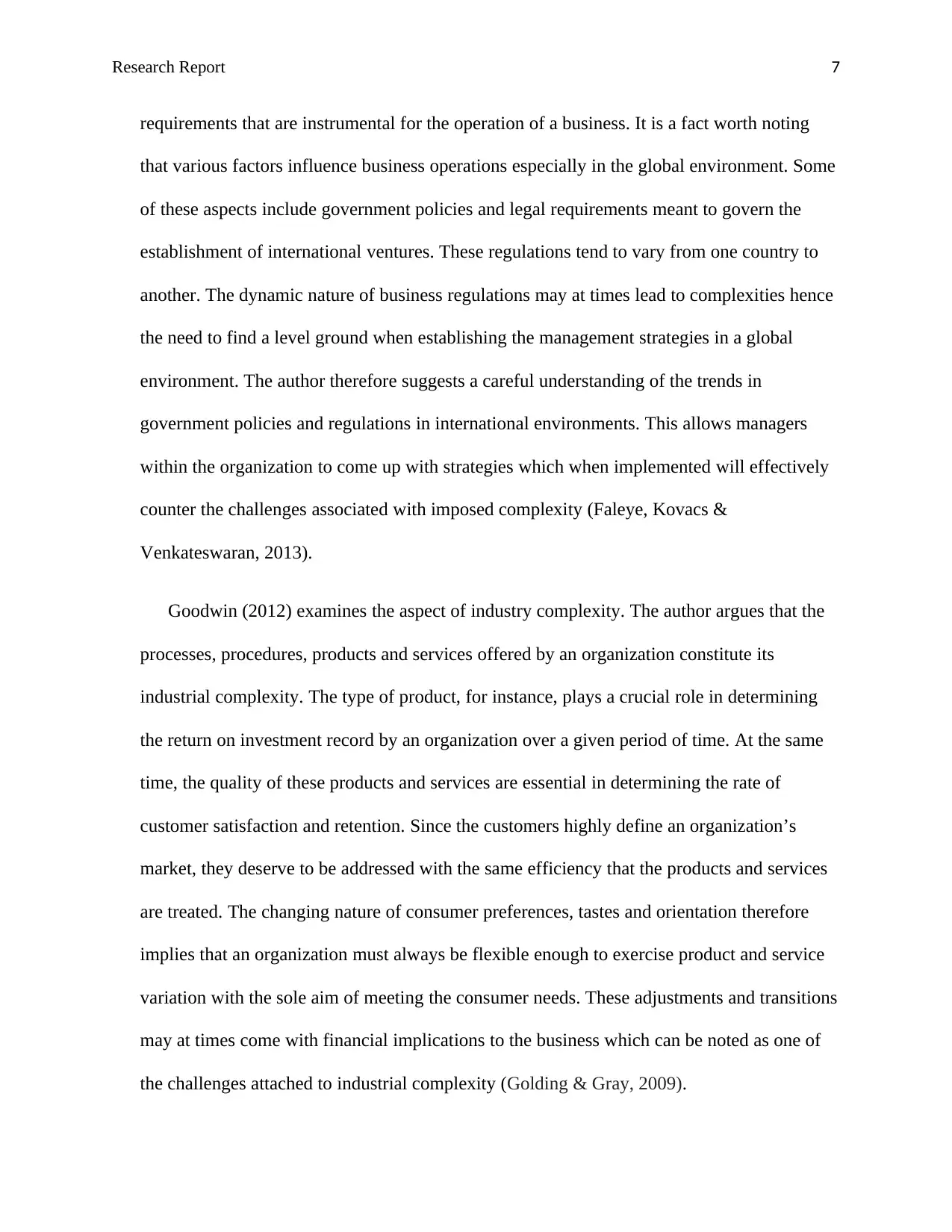
Research Report 7
requirements that are instrumental for the operation of a business. It is a fact worth noting
that various factors influence business operations especially in the global environment. Some
of these aspects include government policies and legal requirements meant to govern the
establishment of international ventures. These regulations tend to vary from one country to
another. The dynamic nature of business regulations may at times lead to complexities hence
the need to find a level ground when establishing the management strategies in a global
environment. The author therefore suggests a careful understanding of the trends in
government policies and regulations in international environments. This allows managers
within the organization to come up with strategies which when implemented will effectively
counter the challenges associated with imposed complexity (Faleye, Kovacs &
Venkateswaran, 2013).
Goodwin (2012) examines the aspect of industry complexity. The author argues that the
processes, procedures, products and services offered by an organization constitute its
industrial complexity. The type of product, for instance, plays a crucial role in determining
the return on investment record by an organization over a given period of time. At the same
time, the quality of these products and services are essential in determining the rate of
customer satisfaction and retention. Since the customers highly define an organization’s
market, they deserve to be addressed with the same efficiency that the products and services
are treated. The changing nature of consumer preferences, tastes and orientation therefore
implies that an organization must always be flexible enough to exercise product and service
variation with the sole aim of meeting the consumer needs. These adjustments and transitions
may at times come with financial implications to the business which can be noted as one of
the challenges attached to industrial complexity (Golding & Gray, 2009).
requirements that are instrumental for the operation of a business. It is a fact worth noting
that various factors influence business operations especially in the global environment. Some
of these aspects include government policies and legal requirements meant to govern the
establishment of international ventures. These regulations tend to vary from one country to
another. The dynamic nature of business regulations may at times lead to complexities hence
the need to find a level ground when establishing the management strategies in a global
environment. The author therefore suggests a careful understanding of the trends in
government policies and regulations in international environments. This allows managers
within the organization to come up with strategies which when implemented will effectively
counter the challenges associated with imposed complexity (Faleye, Kovacs &
Venkateswaran, 2013).
Goodwin (2012) examines the aspect of industry complexity. The author argues that the
processes, procedures, products and services offered by an organization constitute its
industrial complexity. The type of product, for instance, plays a crucial role in determining
the return on investment record by an organization over a given period of time. At the same
time, the quality of these products and services are essential in determining the rate of
customer satisfaction and retention. Since the customers highly define an organization’s
market, they deserve to be addressed with the same efficiency that the products and services
are treated. The changing nature of consumer preferences, tastes and orientation therefore
implies that an organization must always be flexible enough to exercise product and service
variation with the sole aim of meeting the consumer needs. These adjustments and transitions
may at times come with financial implications to the business which can be noted as one of
the challenges attached to industrial complexity (Golding & Gray, 2009).
Paraphrase This Document
Need a fresh take? Get an instant paraphrase of this document with our AI Paraphraser
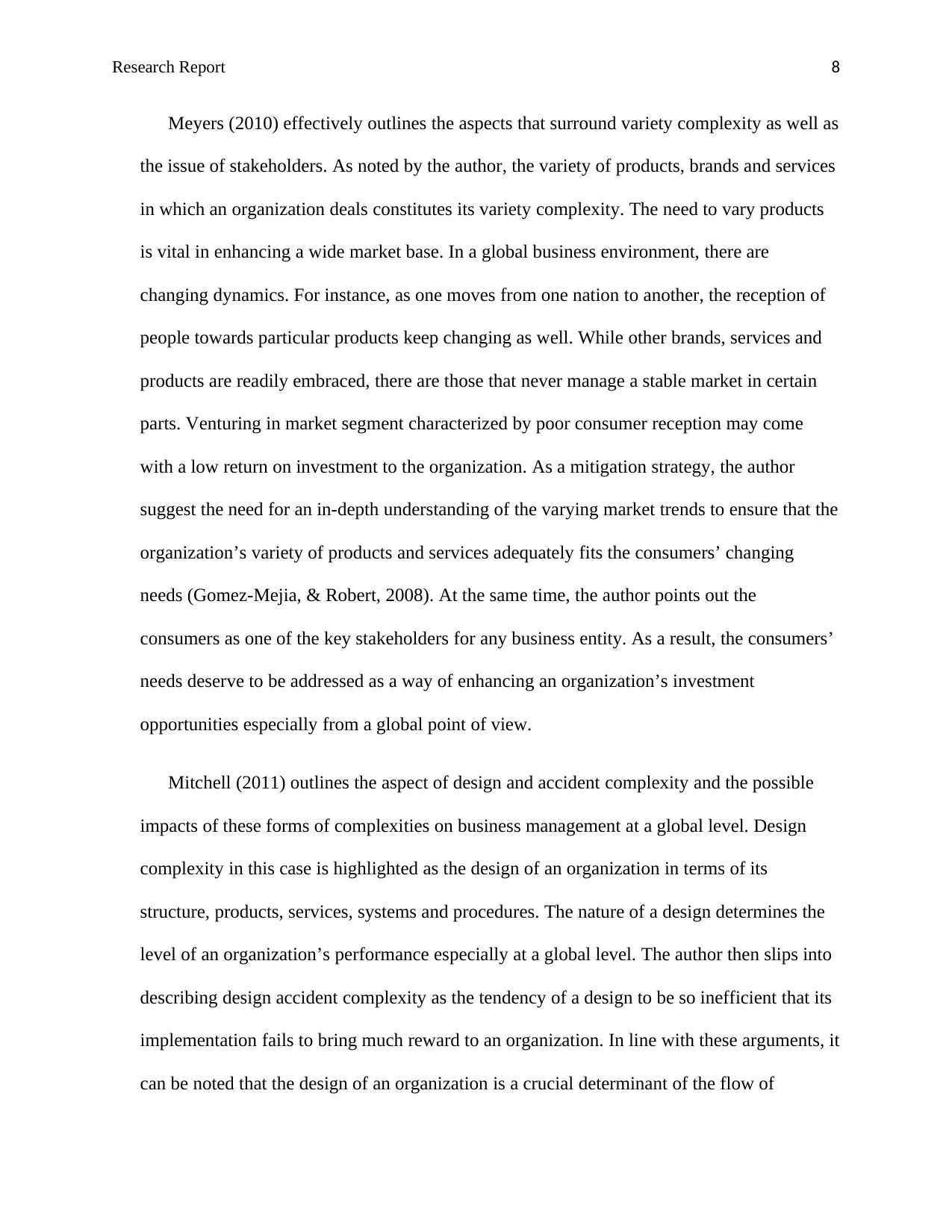
Research Report 8
Meyers (2010) effectively outlines the aspects that surround variety complexity as well as
the issue of stakeholders. As noted by the author, the variety of products, brands and services
in which an organization deals constitutes its variety complexity. The need to vary products
is vital in enhancing a wide market base. In a global business environment, there are
changing dynamics. For instance, as one moves from one nation to another, the reception of
people towards particular products keep changing as well. While other brands, services and
products are readily embraced, there are those that never manage a stable market in certain
parts. Venturing in market segment characterized by poor consumer reception may come
with a low return on investment to the organization. As a mitigation strategy, the author
suggest the need for an in-depth understanding of the varying market trends to ensure that the
organization’s variety of products and services adequately fits the consumers’ changing
needs (Gomez-Mejia, & Robert, 2008). At the same time, the author points out the
consumers as one of the key stakeholders for any business entity. As a result, the consumers’
needs deserve to be addressed as a way of enhancing an organization’s investment
opportunities especially from a global point of view.
Mitchell (2011) outlines the aspect of design and accident complexity and the possible
impacts of these forms of complexities on business management at a global level. Design
complexity in this case is highlighted as the design of an organization in terms of its
structure, products, services, systems and procedures. The nature of a design determines the
level of an organization’s performance especially at a global level. The author then slips into
describing design accident complexity as the tendency of a design to be so inefficient that its
implementation fails to bring much reward to an organization. In line with these arguments, it
can be noted that the design of an organization is a crucial determinant of the flow of
Meyers (2010) effectively outlines the aspects that surround variety complexity as well as
the issue of stakeholders. As noted by the author, the variety of products, brands and services
in which an organization deals constitutes its variety complexity. The need to vary products
is vital in enhancing a wide market base. In a global business environment, there are
changing dynamics. For instance, as one moves from one nation to another, the reception of
people towards particular products keep changing as well. While other brands, services and
products are readily embraced, there are those that never manage a stable market in certain
parts. Venturing in market segment characterized by poor consumer reception may come
with a low return on investment to the organization. As a mitigation strategy, the author
suggest the need for an in-depth understanding of the varying market trends to ensure that the
organization’s variety of products and services adequately fits the consumers’ changing
needs (Gomez-Mejia, & Robert, 2008). At the same time, the author points out the
consumers as one of the key stakeholders for any business entity. As a result, the consumers’
needs deserve to be addressed as a way of enhancing an organization’s investment
opportunities especially from a global point of view.
Mitchell (2011) outlines the aspect of design and accident complexity and the possible
impacts of these forms of complexities on business management at a global level. Design
complexity in this case is highlighted as the design of an organization in terms of its
structure, products, services, systems and procedures. The nature of a design determines the
level of an organization’s performance especially at a global level. The author then slips into
describing design accident complexity as the tendency of a design to be so inefficient that its
implementation fails to bring much reward to an organization. In line with these arguments, it
can be noted that the design of an organization is a crucial determinant of the flow of
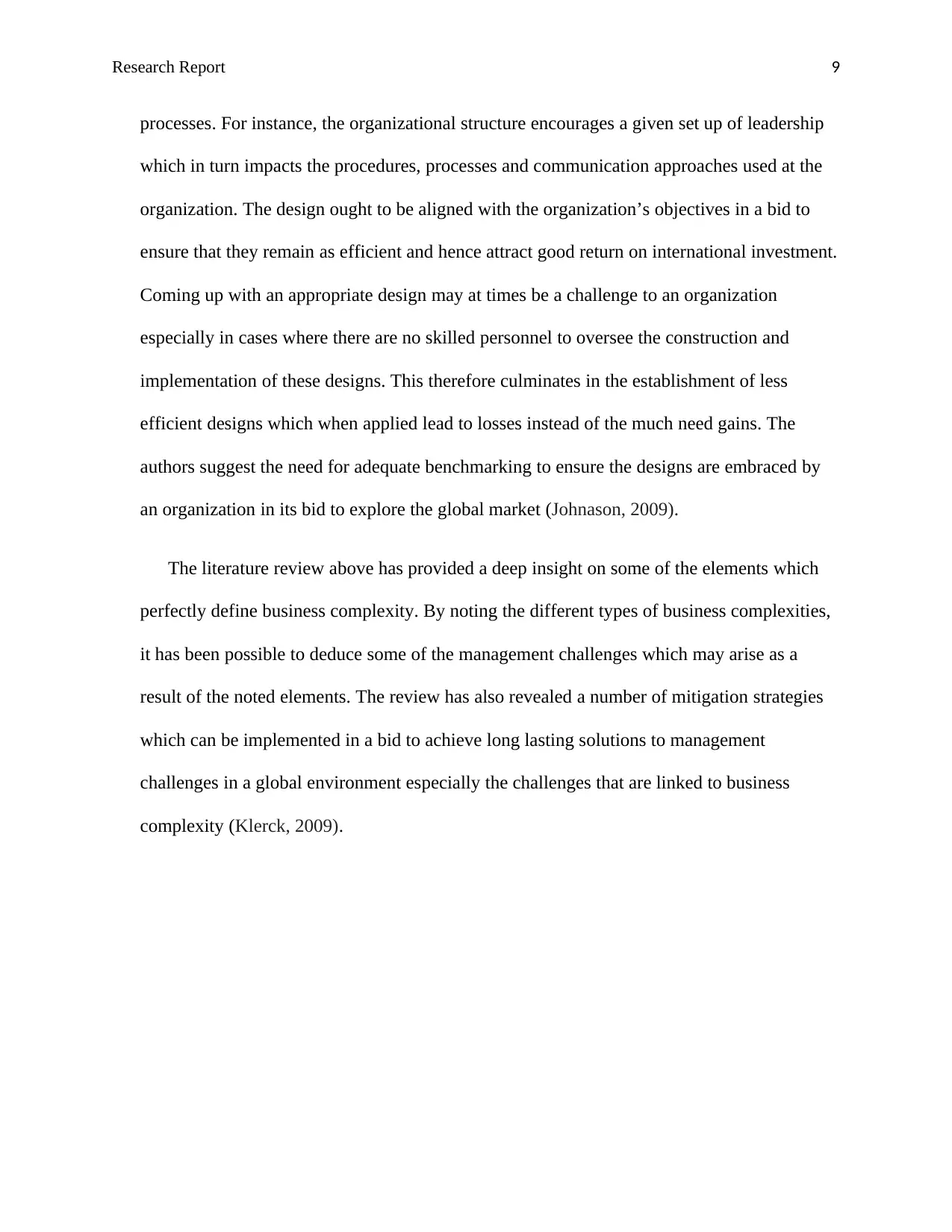
Research Report 9
processes. For instance, the organizational structure encourages a given set up of leadership
which in turn impacts the procedures, processes and communication approaches used at the
organization. The design ought to be aligned with the organization’s objectives in a bid to
ensure that they remain as efficient and hence attract good return on international investment.
Coming up with an appropriate design may at times be a challenge to an organization
especially in cases where there are no skilled personnel to oversee the construction and
implementation of these designs. This therefore culminates in the establishment of less
efficient designs which when applied lead to losses instead of the much need gains. The
authors suggest the need for adequate benchmarking to ensure the designs are embraced by
an organization in its bid to explore the global market (Johnason, 2009).
The literature review above has provided a deep insight on some of the elements which
perfectly define business complexity. By noting the different types of business complexities,
it has been possible to deduce some of the management challenges which may arise as a
result of the noted elements. The review has also revealed a number of mitigation strategies
which can be implemented in a bid to achieve long lasting solutions to management
challenges in a global environment especially the challenges that are linked to business
complexity (Klerck, 2009).
processes. For instance, the organizational structure encourages a given set up of leadership
which in turn impacts the procedures, processes and communication approaches used at the
organization. The design ought to be aligned with the organization’s objectives in a bid to
ensure that they remain as efficient and hence attract good return on international investment.
Coming up with an appropriate design may at times be a challenge to an organization
especially in cases where there are no skilled personnel to oversee the construction and
implementation of these designs. This therefore culminates in the establishment of less
efficient designs which when applied lead to losses instead of the much need gains. The
authors suggest the need for adequate benchmarking to ensure the designs are embraced by
an organization in its bid to explore the global market (Johnason, 2009).
The literature review above has provided a deep insight on some of the elements which
perfectly define business complexity. By noting the different types of business complexities,
it has been possible to deduce some of the management challenges which may arise as a
result of the noted elements. The review has also revealed a number of mitigation strategies
which can be implemented in a bid to achieve long lasting solutions to management
challenges in a global environment especially the challenges that are linked to business
complexity (Klerck, 2009).
⊘ This is a preview!⊘
Do you want full access?
Subscribe today to unlock all pages.

Trusted by 1+ million students worldwide
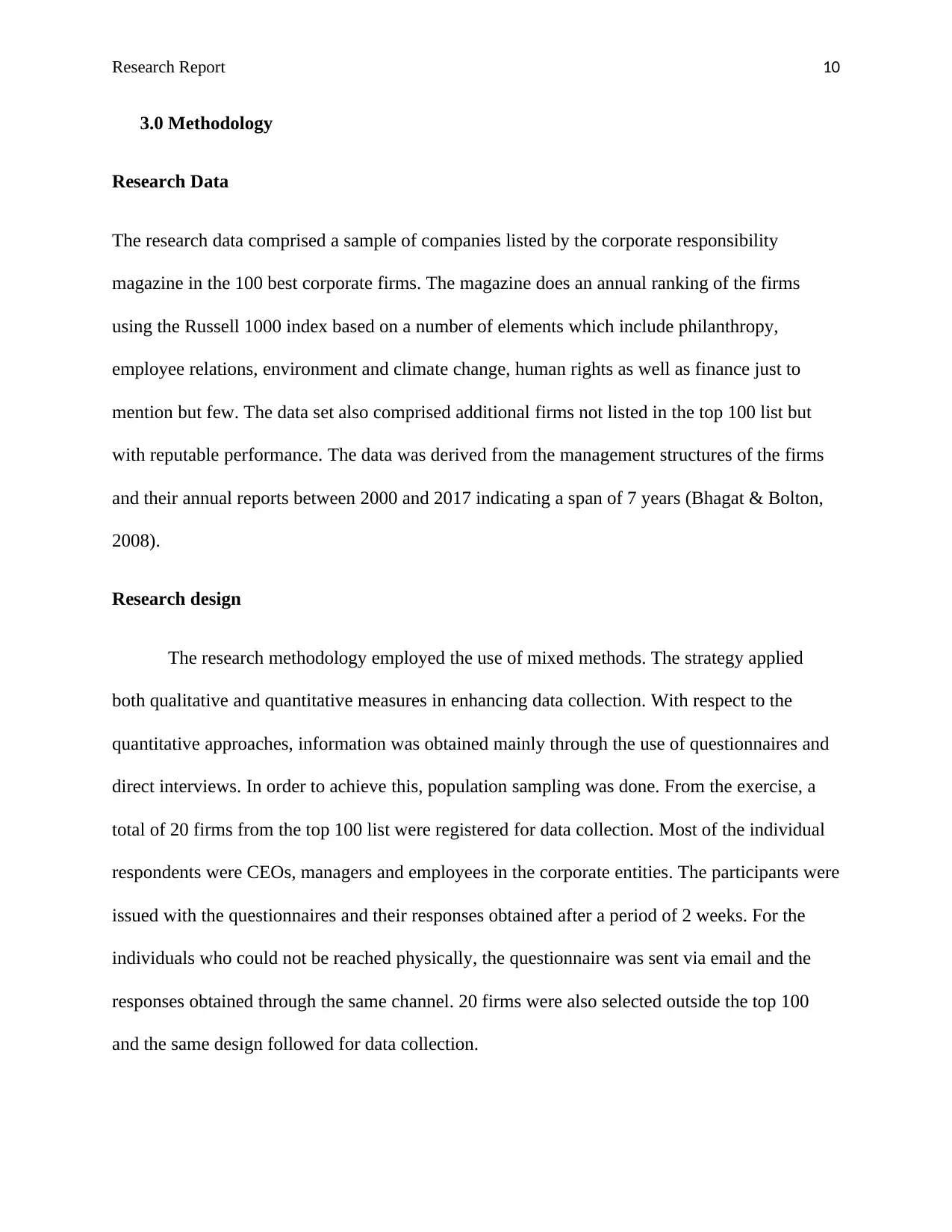
Research Report 10
3.0 Methodology
Research Data
The research data comprised a sample of companies listed by the corporate responsibility
magazine in the 100 best corporate firms. The magazine does an annual ranking of the firms
using the Russell 1000 index based on a number of elements which include philanthropy,
employee relations, environment and climate change, human rights as well as finance just to
mention but few. The data set also comprised additional firms not listed in the top 100 list but
with reputable performance. The data was derived from the management structures of the firms
and their annual reports between 2000 and 2017 indicating a span of 7 years (Bhagat & Bolton,
2008).
Research design
The research methodology employed the use of mixed methods. The strategy applied
both qualitative and quantitative measures in enhancing data collection. With respect to the
quantitative approaches, information was obtained mainly through the use of questionnaires and
direct interviews. In order to achieve this, population sampling was done. From the exercise, a
total of 20 firms from the top 100 list were registered for data collection. Most of the individual
respondents were CEOs, managers and employees in the corporate entities. The participants were
issued with the questionnaires and their responses obtained after a period of 2 weeks. For the
individuals who could not be reached physically, the questionnaire was sent via email and the
responses obtained through the same channel. 20 firms were also selected outside the top 100
and the same design followed for data collection.
3.0 Methodology
Research Data
The research data comprised a sample of companies listed by the corporate responsibility
magazine in the 100 best corporate firms. The magazine does an annual ranking of the firms
using the Russell 1000 index based on a number of elements which include philanthropy,
employee relations, environment and climate change, human rights as well as finance just to
mention but few. The data set also comprised additional firms not listed in the top 100 list but
with reputable performance. The data was derived from the management structures of the firms
and their annual reports between 2000 and 2017 indicating a span of 7 years (Bhagat & Bolton,
2008).
Research design
The research methodology employed the use of mixed methods. The strategy applied
both qualitative and quantitative measures in enhancing data collection. With respect to the
quantitative approaches, information was obtained mainly through the use of questionnaires and
direct interviews. In order to achieve this, population sampling was done. From the exercise, a
total of 20 firms from the top 100 list were registered for data collection. Most of the individual
respondents were CEOs, managers and employees in the corporate entities. The participants were
issued with the questionnaires and their responses obtained after a period of 2 weeks. For the
individuals who could not be reached physically, the questionnaire was sent via email and the
responses obtained through the same channel. 20 firms were also selected outside the top 100
and the same design followed for data collection.
Paraphrase This Document
Need a fresh take? Get an instant paraphrase of this document with our AI Paraphraser
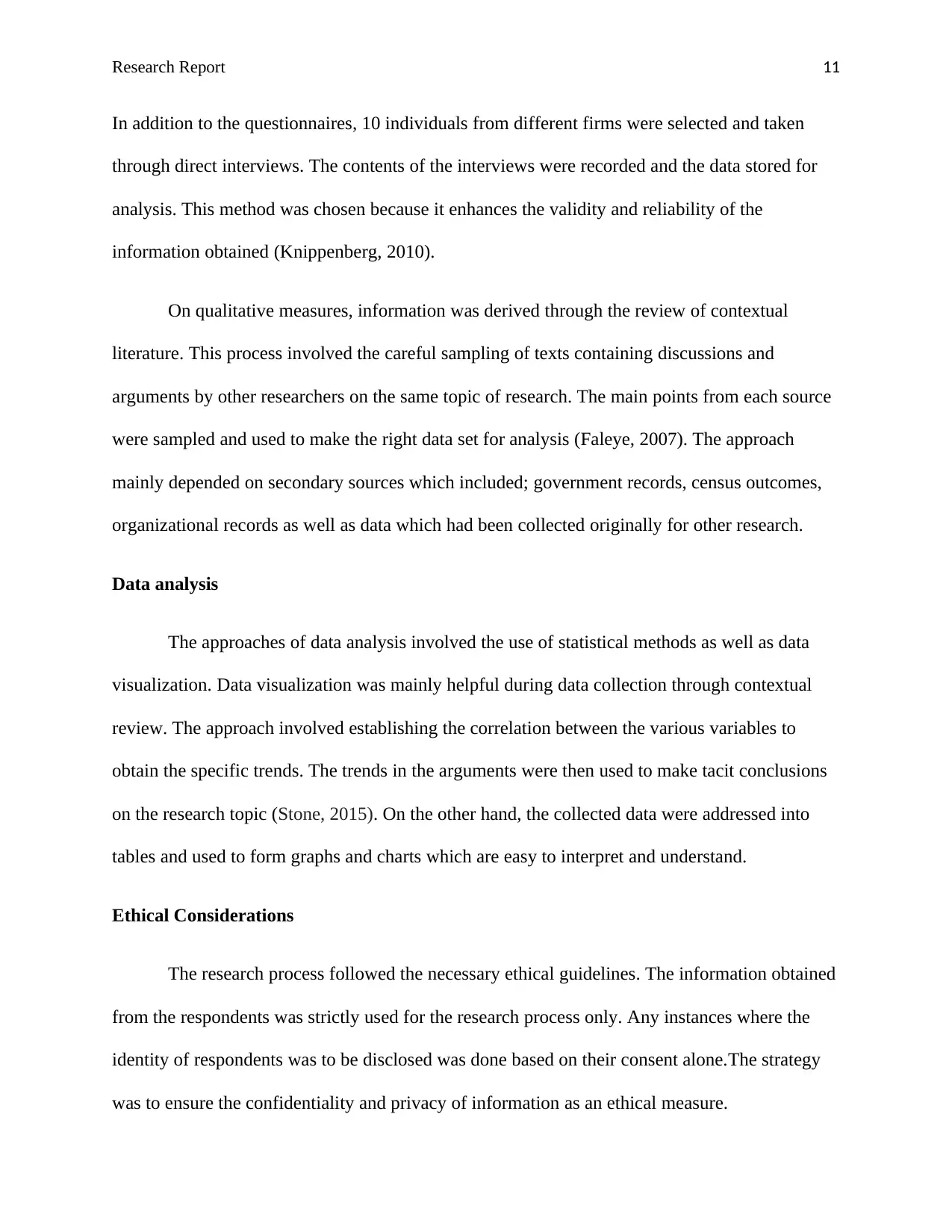
Research Report 11
In addition to the questionnaires, 10 individuals from different firms were selected and taken
through direct interviews. The contents of the interviews were recorded and the data stored for
analysis. This method was chosen because it enhances the validity and reliability of the
information obtained (Knippenberg, 2010).
On qualitative measures, information was derived through the review of contextual
literature. This process involved the careful sampling of texts containing discussions and
arguments by other researchers on the same topic of research. The main points from each source
were sampled and used to make the right data set for analysis (Faleye, 2007). The approach
mainly depended on secondary sources which included; government records, census outcomes,
organizational records as well as data which had been collected originally for other research.
Data analysis
The approaches of data analysis involved the use of statistical methods as well as data
visualization. Data visualization was mainly helpful during data collection through contextual
review. The approach involved establishing the correlation between the various variables to
obtain the specific trends. The trends in the arguments were then used to make tacit conclusions
on the research topic (Stone, 2015). On the other hand, the collected data were addressed into
tables and used to form graphs and charts which are easy to interpret and understand.
Ethical Considerations
The research process followed the necessary ethical guidelines. The information obtained
from the respondents was strictly used for the research process only. Any instances where the
identity of respondents was to be disclosed was done based on their consent alone.The strategy
was to ensure the confidentiality and privacy of information as an ethical measure.
In addition to the questionnaires, 10 individuals from different firms were selected and taken
through direct interviews. The contents of the interviews were recorded and the data stored for
analysis. This method was chosen because it enhances the validity and reliability of the
information obtained (Knippenberg, 2010).
On qualitative measures, information was derived through the review of contextual
literature. This process involved the careful sampling of texts containing discussions and
arguments by other researchers on the same topic of research. The main points from each source
were sampled and used to make the right data set for analysis (Faleye, 2007). The approach
mainly depended on secondary sources which included; government records, census outcomes,
organizational records as well as data which had been collected originally for other research.
Data analysis
The approaches of data analysis involved the use of statistical methods as well as data
visualization. Data visualization was mainly helpful during data collection through contextual
review. The approach involved establishing the correlation between the various variables to
obtain the specific trends. The trends in the arguments were then used to make tacit conclusions
on the research topic (Stone, 2015). On the other hand, the collected data were addressed into
tables and used to form graphs and charts which are easy to interpret and understand.
Ethical Considerations
The research process followed the necessary ethical guidelines. The information obtained
from the respondents was strictly used for the research process only. Any instances where the
identity of respondents was to be disclosed was done based on their consent alone.The strategy
was to ensure the confidentiality and privacy of information as an ethical measure.
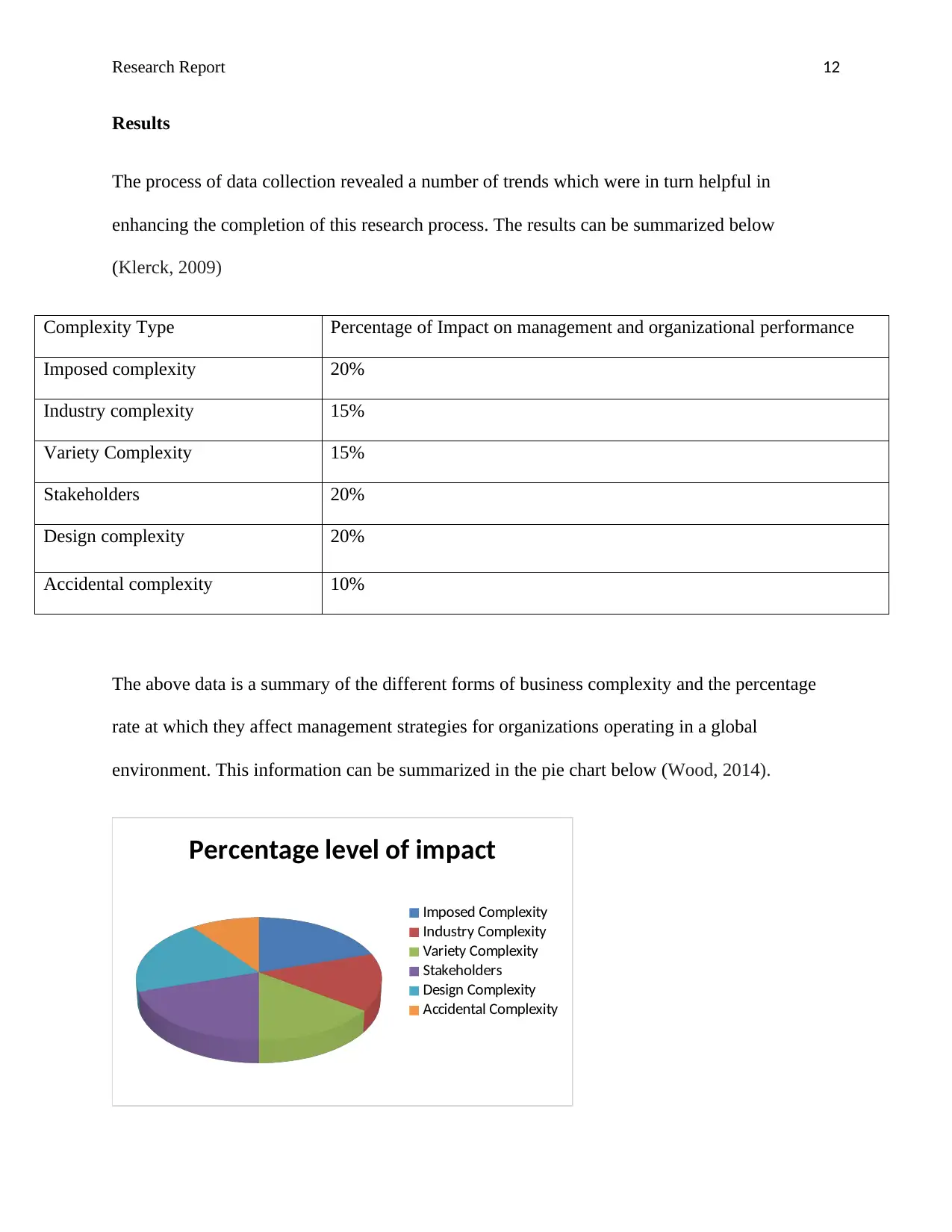
Research Report 12
Results
The process of data collection revealed a number of trends which were in turn helpful in
enhancing the completion of this research process. The results can be summarized below
(Klerck, 2009)
Complexity Type Percentage of Impact on management and organizational performance
Imposed complexity 20%
Industry complexity 15%
Variety Complexity 15%
Stakeholders 20%
Design complexity 20%
Accidental complexity 10%
The above data is a summary of the different forms of business complexity and the percentage
rate at which they affect management strategies for organizations operating in a global
environment. This information can be summarized in the pie chart below (Wood, 2014).
Percentage level of impact
Imposed Complexity
Industry Complexity
Variety Complexity
Stakeholders
Design Complexity
Accidental Complexity
Results
The process of data collection revealed a number of trends which were in turn helpful in
enhancing the completion of this research process. The results can be summarized below
(Klerck, 2009)
Complexity Type Percentage of Impact on management and organizational performance
Imposed complexity 20%
Industry complexity 15%
Variety Complexity 15%
Stakeholders 20%
Design complexity 20%
Accidental complexity 10%
The above data is a summary of the different forms of business complexity and the percentage
rate at which they affect management strategies for organizations operating in a global
environment. This information can be summarized in the pie chart below (Wood, 2014).
Percentage level of impact
Imposed Complexity
Industry Complexity
Variety Complexity
Stakeholders
Design Complexity
Accidental Complexity
⊘ This is a preview!⊘
Do you want full access?
Subscribe today to unlock all pages.

Trusted by 1+ million students worldwide
1 out of 18
Related Documents
Your All-in-One AI-Powered Toolkit for Academic Success.
+13062052269
info@desklib.com
Available 24*7 on WhatsApp / Email
![[object Object]](/_next/static/media/star-bottom.7253800d.svg)
Unlock your academic potential
Copyright © 2020–2025 A2Z Services. All Rights Reserved. Developed and managed by ZUCOL.




